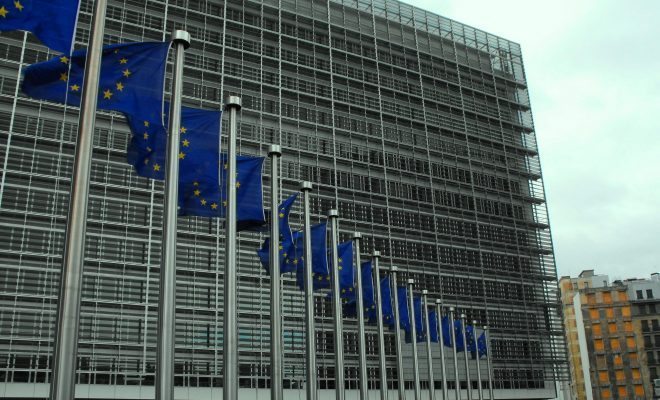 Image courtesy of [Leon Yaakov via Flickr]
Image courtesy of [Leon Yaakov via Flickr]
World
Right-Wing Groups in Europe: A Rising Force?
The violence in Paris several weeks ago united Europe as little else has in recent years. Plagued by economic decline, some of the more prosperous nations have voiced discontent with the state of the European Union. Partly leading this surge is a wave of far-right political movements. These nationalist movements are gaining traction from Berlin to Paris to London as people tire of stagnant economic growth and demands for bail outs.
Additionally in many of these countries, a dramatic demographic change is occurring in which traditional peoples and cultures are finding themselves increasingly co-habitating with people who have different beliefs and practices. Read on to learn about the political shift and rise of right-wing groups in Europe after years of economic concerns and changing demographics in the region.
History of the European Union
The European Union, unsurprisingly, traces its roots to the aftermath of WWII. With the continent in ruins, several representatives from leading nations attempted to finally find some way to unify the region and put an end to the seemingly endless fighting that had just led to the most destructive war the world has ever known.
The process started with the European Coal and Steel Community in 1951, which had six founding members: West Germany, France, Italy, Belgium, Luxembourg, and the Netherlands. These six nations agreed to unite their coal and steel production. The foundation was built up further with the Treaty of Rome in 1957, which created the European Economic Community (EEC). In 1967 the European Parliament was created and in 1979 it had its first direct elections.
The European Union itself was codified in 1993 through the Treaty of Maastricht. In 2002, the Euro replaced the currency of 12 of the 15 members of the organization. The Euro reached its highest value against the dollar in 2008; however, like much of the rest of the developed world, the EU was then rocked by the global economic crisis. Since this time, the EU has been attempting to fight off recession and recover, with the only real bright spot being the addition of its twenty-eighth member country Croatia in 2013. The video below gives a succinct explanation of the EU.
Economic Turmoil
In 2008 the global financial crisis hit the European Union and the results have been devastating both economically and with regard to the unity of the region.
The Rich
The economic crisis has hit both rich and poor countries within the Eurozone alike. While many of the rich countries were not in need of bail outs, they still suffered from high debt. First, they had to bail out those troubled fellow EU members that were unable to pay off their high debts after the crisis hit. They also lost markets to sell goods as the cash-strapped nations to the south could not afford to buy as much of their products.
Furthermore, while some indicators of a healthy economy appear to show rich countries in the EU doing well, these can be misleading. In the case of Germany for example, unemployment sits at a very respectable five percent; however, economic growth is virtually flat. In the third quarter of 2014 the economy only grew 0.1 percent, which followed on the heels of a second quarter in which Germany’s economy actually shrunk by 0.1 percent.
Germany is far from the only and certainly not the worst-off wealthy nation in the Eurozone either. France, the second largest economy in the EU, has an unemployment rate of over ten percent and grew only 0.3 percent during the third quarter of 2013. This miniscule growth, similar to that of Germany, also followed a second quarter contraction. Other cases include Spain, the number four economy, and Italy, the number three economy in the Eurozone, with unemployment rates of about 24 percent and 13 percent respectfully.
The Struggling
While the economic crisis certainly hit both wealthy and poor European nations, as is usually the case, the less robust economies ended up worse off. It begins of course with the bail outs. Ireland, Portugal, Greece, Spain, and Cyprus all had to accept large sums of money from other EU members to avoid default.
Furthermore, as a result of the bail outs, these countries and others struggling with the debt crisis have had to employ austerity measures; however, this strategy limits growth especially because creditors will be hesitant to lend money to struggling economies. This then creates a brutal cycle in which these countries have a difficult time paying off their debts because growth is low and unemployment will remain high. The video below gives a great explanation of the European Union’s economic problems.
Changing Demographics
Coupled with a shaky economic situation are dramatic demographic changes in Europe. This change can be divided into three categories: fertility, age, and ethnicity. First Europe as a whole has a very low fertility rate. Fertility rate is basically the number of children a family can expect to have during its childbearing years. Replacement level, or the level of children being born needed to adequately replace the existing population, is 2.1 children. In 2012 the average fertility rate for countries within the European Union was 1.6 children–well below replacement levels.
Since fewer children are being born, the average populations of these countries are rapidly aging. In Poland for example, the percentage of people above the working age population, 15-64, is expected to increase from 20.9 percent in 2010 to 58 percent in 2050. A large aging population can be a double edged sword, as not only are older people more dependent on public services such as health care and pensions, but they are also less productive in the economy and save less, which affects investing.
Thus a lack of new labor and a society that increasingly needs it has led to mass migration in Europe. This migration can be broken down into two groups. First is the traditional type of immigration, specifically from countries outside the EU to countries inside of it. In 2012, for example, 1.7 million people migrated to the European Union. The other type of migration is within the European Union itself; this figure also was approximately 1.7 million for the year 2012. Both types of migration are headed in one specific direction–west. Western European nations, which not coincidentally have the best economies, are bearing the brunt of the mass movements. The top five destinations in order of descending immigrant arrivals were Germany, the UK, Italy, France, and Spain.
It’s also important to note the origin of the people immigrating. Many are coming from Eastern Europe. A large portion of the incoming people and groups are also Muslim. While it cannot be reiterated enough that the vast majority of Muslim immigrants are in every way able adaptable to European life, there is tension in Europe over this influx. Current events, such as the fact that it has been estimated that currently as many as three thousand European-born Muslims have fought on behalf of ISIS or other extremist groups in the Middle East, haven’t helped this tension.
While fear of these fighters returning home has far outstripped any actual problems, the recent shootings in Paris show what can occur when a marginalized group becomes incredibly radicalized. Unfortunately this image of radicalized Muslims plays perfectly into the hands of politicians and right-wing groups that have come to prominence at the expense of immigrant groups.
Europe has a long history of xenophobia. When it deals with mass immigration, the fear has turned into Islamaphobia. While western Europeans may not be particularly thrilled with eastern European immigrants, Muslims are being singled out in particular because of their different culture and the historical legacy of conflict between Christian and Muslim areas of Europe and the Middle East. This fear and Islamaphobia also extends to first and second generation Muslims as well, particularly in a time of economic uncertainty.
The Reemergence of the Right Wing
All these issues–economic problems, low fertility rates, and mass immigration–have led to a resurgence in the power and appeal of right-wing parties in Europe. More specifically, what has led to this rise is how economic problems are perceived as being compounded by immigration. For example, in the European Union the youth unemployment rate as a whole is 23 percent; in Greece it has been as high as 60 percent.
In a sadly ironic twist the backlash to this has usually been against immigrants who are perceived as stealing the few precious jobs that are available; however, immigration is necessary in the first place because the birth rates are so low. Additionally, immigrant populations have even higher unemployment rates than native youth.
As a result of these concerns, in recent elections several far-right parties including France’s Front National, Greece’s Golden Dawn, Hungary’s Jobbik, and the United Kingdom’s UKIP all won a surprising number of votes. Each of these parties display different combinations of outward anti-Semitism, anti-immigrant sentiments, and racism, or have been associated with such traits in the past. While this by no means represents a majority, it does indicate a disturbing trend for the European Union.
While it seems clear that far-right political movements are on the rise in Europe, the question turns to what exactly these groups want. Just like other political groups, especially across national lines, their interests vary. Overall, the focus seems to be anti-immigration, specifically based on a fear that immigrants will take away badly needed jobs from native residents. At the forefront of this movement is the Front National in France, which won the most seats in the European Parliament of any far right party.
The Front National can be characterized as one of the most moderate of the far-right parties coming to power. Its primary focus is on nationalism instead of more overtly far-right ideologies espoused by other groups such as Golden Dawn, Jobbik, and the accused neo-Nazi NPD group in Germany; however, Front National has its roots in exactly the same kinds of dogma that these groups maintain, namely anti-Semitism and racism. This is why the far right party in Britain, the UKIP, has refused to join with them. Thus the main connection these groups all seem to have is strong support for anti-immigration measures, which entails moving away from a united Europe and its open migration policies between nations. The video below provides further explanation of the rise of far-right parties and what they believe.
Current State of the Union
Europe appears to be in serious trouble. Its native population is dwindling because of low fertility rates and an aging population. The people migrating in to fill this void, while on the whole younger, also bring different cultures and mindsets. All this has led to a wave of right-wing parties that are in favor of closing borders, ousting immigrants, and breaking away from the ailing European Union.
Europe’s economy, while growing slightly, is still badly damaged and will likely take years just to return to pre-recession levels. Additionally, fertility rates in Europe show no signs of increasing for the most part, at least in native-born citizens. Without more people to assist the aging population, immigration is also likely to continue. This immigration is also likely to continue from Eastern Europe and nations with different ethnic and cultural backgrounds, which often include large numbers of Muslims.
In the future, however, it seems possible that significant changes could come to the union. First it is possible that the UK leaves the EU. Prime Minister David Cameron has already been cornered into a vote on whether or not to stay in the union. While a vote certainly doesn’t mean anything for certain, the mere fact that it is being forced upon him does. If the UK does leave it could have additional shockwaves on other nations such as France and Germany and may also lower confidence in the EU’s future.
A lot rides on France and Germany. They both have already invested a lot in the European Union and reaped rewards from it, so it might be a stretch for them to leave; however, calls for potential European bank reforms to mimic what they have done nationally shows not only how they view their own importance in Europe, but also is a test of how the other members view them as well.
Conclusion
Far right parties are becoming increasingly popular and powerful in Europe. This has been the result of a number of factors; notably the Eurozone economic crisis, low fertility rates, an aging population, and a large influx in immigrants. Furthermore, every indication shows that these mechanisms are only likely to keep moving down this path and not reverse course. Therefore, while it is too early to give up on the grand experiment of a United States of Europe, serious reforms are needed if the experiment is to work. Reform is also necessary if European leaders hope to quell the rising influence of far-right parties and their supporters.
Resources
Primary
World Bank: Learning About the Unknown: The Economic Impacts of Aging in Europe and Central Asia
European Commission: 2014 Autumn Economic Forecast; Slow Recovery With Very Low Inflation
European Commission: Eurostat; Migration and Migrant Population Statistics
Additional
NPR: A Brief History of the EU
Forbes: Suddenly the EU’s Break-Up Has Moved From a Long Shot to a Probability
The New York Times: Study on Wealth Fuels Euro Crisis Debate in Germany
Statista: Unemployment Rate in Member States of the European Union
Eurostat: Total Fertility Rates
Vienna Institutefor International Economic Studies: Effects of Euro Crisis on Europe’s Periphery
Telegraph: Muslim Europe; The Demographic Time Bomb Transforming Our Continent
CNN: From Antwerp to Aleppo–and Back; Europe’s Nightmare
Guardian: Eurozone Growth Figures; Germany Narrowly Avoids Triple-Dip Recession
New Geography: Will Europe Hit a Demographic Turning Point?
Huffington Post: Sudden Rise of Far-Right Groups in EU Parliament Rings Alarm Bells Across Europe
USA Today: Immigration Backlah is on the Rise in Europe








Comments